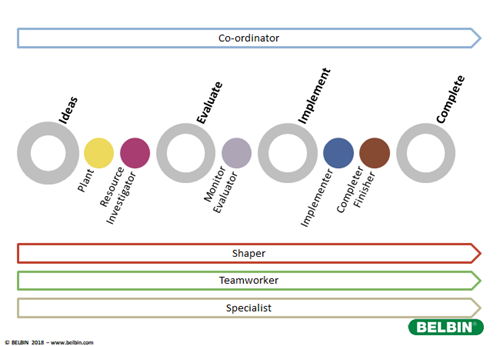Project teams present an opportunity – and a challenge
How do you break the ice and establish rapport quickly? How do you create a collaborative, engaged atmosphere and work towards psychological safety while ensuring the work stays on schedule? How do you overcome cross-disciplinary or inter-departmental competition that can threaten co-operation, and ultimately, success?
It may be tempting to ignore the 'people' element and focus on getting the work done, especially when odds are already stacked against projects running on time, but doing so only exacerbates the problems that are bound to arise.
How do you maximise chances of success for project teams?
Flexibility is key. If you want people to think – and work – outside their usual boundaries, you need to offer a new framework for collaboration.
Exploring the behavioural styles present within your project team allows you to frame individual contributions in a different way.
Rather than focusing on who comes from which geographical region or department, talking Belbin Team Roles places the emphasis on the unique set of strengths each person has to offer, opens up new opportunities for collaboration beyond job titles and descriptions, and highlights common ground – or synergy – with others in the team.

Read our article
Belbin in project teams: how behavioural diversity boosts team performance, published in IAPM International Association of Project Managers. Click here.

Finding the perfect fit
Ideally, behavioural styles should be used to help form – and inform – your project team.
Too often, project teams possess a broad range of hard skills and expertise, but are lacking the behavioural diversity needed for success.
If the team is already assembled, it’s still important to use an understanding of Belbin Team Role strengths to determine who should be involved at each stage.
Linking the work to the Team Role
When working on a project, it is standard practice to break down the project in terms of the work that needs to be done.
We project-manage the work, add timeframes, and arrange meetings to check that the work is on schedule. There is an industry created to provide the tools to accomplish this.
But how often is the human element taken into consideration?
When delineating the series of tasks that make up a project, time needs to be taken to consider which Belbin Team Role behaviours are best suited to each.
Once this discussion has been taken, it is a straightforward next step to allocate the work to the person who has those Belbin Team Role behaviours.

Here's how a project might look, in Team Role terms

In this case, it is the role of the Co-ordinator to oversee the project, ensuring that the Shaper behaviour is involved when deadlines start looming. The Teamworker behaviour becomes critical when diplomacy and empathy are needed to smooth waters, and the Specialist, when an in-depth understanding of the brief is called for.
Ensuring that only the required people are present at each stage of the project will mean less frustration (and fewer time-consuming meetings) for everyone involved.

Keeping the team on track
Feedback may not be possible initially (if team members are relative strangers), but should be feasible once the team has been working together for a few months.
Asking the team to complete Observer Assessments for one another offers an opportunity to ‘check in’, revisit their contributions and articulate any discrepancies between the roles they seek to play and the expectations of others in the team.
If conflicts are beginning to arise, this provides a chance for reflection, before interpersonal difficulties pull the team’s efforts off-course. Discussions – both with a manager, and between colleagues – might give rise to important revelations about the way the team operates.
Helping your people articulate the challenges of working in a project team
Communication is key. Give people the opportunity to talk about themselves - how they prefer to work, what frustrates them...
Encouraging these conversations, preferably with a Belbin Individual report to hand, will aid understanding of the roles each needs to play within the project.
- “I work best when I can… because…”
For those whose Team Role image squares neatly with others’ view of their behaviours, adding Observer feedback serves as an opportunity to declare their strengths and reinforce the positive impact of their role within the team.
- “I get frustrated or disengaged when this happens, because…”
Of course, even when playing to our strengths (best-case scenario), we expect associated weaknesses to come into play.
Explaining how and why we struggle, or experience frustration or disappointment, is key to managing those weaknesses for the good of the team. It can be as simple as relieving a high-scoring Teamworker of pressured decision-making, or shifting follow-up from the desk of an out-and-out Resource Investigator to that of an Implementer / Completer Finisher, who is more likely to relish the task.
- “I play different roles on my other team.”
Is the individual enjoying the challenge of exploring distinct roles in a new team context? What are the challenges of a shifting Belbin Team Role identity?
- “I want to be doing more of this,” or “You don’t see all these other things I can do.”
Perhaps the project only utilises part of the person’s Team Role arsenal of strengths, or these strengths just haven’t been clearly articulated to the new team? If appropriate, how might the individual present and develop these strengths for the team’s benefit?
- “I can do this for now, but it doesn’t come naturally.”
Sometimes, project teams can cause greater Team Role strain, pulling an individual out of role to fulfil a particular Belbin Team Role requirement. If the strain is short-term – and if it is recognised and appreciated by others in the team – this can help alleviate the negative effects for the individual in question.
Useful exercise to aid communication
With your Belbin Individual report to hand, take time to describe to others how you work best. Listen to the rest of your team and work out strategies to harness strengths and manage potential conflict.
Taken from the webinar "Using Belbin to form high-performing teams."
Troubleshooting common problems in project teams
So, what happens when – in spite of best efforts – the project team hits a roadblock? First, it’s important to root out any behavioural issues underlying the problem, and then to consider whether the solution also lies with different behavioural approaches.
Spending too long in initial phases
If the team is high in Plant and Resource Investigator behaviours, and is lacking task-focused behaviours (Shaper, Implementer, Completer Finisher), it’s possible to become stuck at the beginning of the project, with creative individuals battling to push their idea to the top of the pile, or stuck in reconnaissance.
A Shaper contribution is needed to push for a solution and drive things forward, whilst Implementer and Completer Finisher styles will be required to ensure that plans are carried out, and to a high standard.


Paralysis by analysis/death by discussion
If the team is over-represented in Monitor Evaluator (and even Co-ordinator) behaviours, it can be difficult to move past discussion to action.
As well as leaving the team behind schedule, this can also prove frustrating to other team members who want to move things forward.
Planning too early or getting bogged down in detail
On the other hand, if those whose contributions come into play at the end of a project (Implementers and Completer Finishers) are allowed in on the action too soon, the team can be led to settle on an inadequate or poorly-researched solution, in the name of getting things done and producing a result.
Skipping the research
While we’re on the subject of research, Resource Investigator and Specialist contributions may be needed to ensure that the team is abreast of its competition, and to provide specific knowledge and expertise respectively.
Without these behaviours, the team is at risk of missing a key piece of intelligence which could compromise success.
Finding your own team's equilibrium
Of course, every team’s requirements are different – the precise Belbin Team Role balance required will depend on the specific parameters of the project.
The important thing? To consider behavioural diversity at all stages in the project team’s life-cycle, for the best chances of success.
Contact us today to discover how Belbin helps project teams in action.
Contact us
Please fill out the form and we'll be in touch.
Discover individual and team strengths using Belbin Team Role reports

Belbin Individual Reports
Before you can analyse your teams, you need to look at each individual's contribution. So, the first thing you will need to do is to generate a Belbin Individual report for each member of the team.
Find out more
Belbin Team Reports
Whether you're forming a new team, introducing new people to an existing team, or trying to resolve issues within a team, a Belbin Team report can help you to manage it.
Discover more
Why Use Belbin?
Belbin Team Roles are used to identify behavioural strengths and weaknesses in the workplace. Whether developing people, resolving conflict or fine-tuning high performance...
Read more